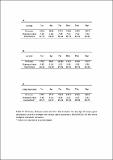Por favor, use este identificador para citar o enlazar a este item:
http://hdl.handle.net/10261/147168COMPARTIR / EXPORTAR:
 SHARE SHARE
 CORE
BASE CORE
BASE
|
|
| Visualizar otros formatos: MARC | Dublin Core | RDF | ORE | MODS | METS | DIDL | DATACITE | |

| Título: | Functional ecology of soil microbial communities along a glacier forefield in Tierra del Fuego (Chile) [Supporting material] |
Autor: | Fernández Martínez, Miguel Ángel CSIC ORCID; Pointing, Stephen B.; Pérez-Ortega, Sergio; Arróniz Crespo, María; Green, T. G. Allan; Rozzi, Ricardo; Sancho, Leopoldo G.; Ríos, Asunción de los CSIC ORCID | Fecha de publicación: | 2016 | Editor: | Springer Nature | Citación: | International Microbiology 19(3): 161-173 (2016) | Resumen: | A previously established chronosequence from Pia Glacier forefield in Tierra del Fuego (Chile) containing soils of different ages (from bare soils to forest ones) is analyzed. We used this chronosequence as framework to postulate that microbial successional development would be accompanied by changes in functionality. To test this, the GeoChip functional microarray was used to identify diversity of genes involved in microbial carbon and nitrogen metabolism, as well as other genes related to microbial stress response and biotic interactions. Changes in putative functionality generally reflected succession-related taxonomic composition of soil microbiota. Major shifts in carbon fixation and catabolism were observed, as well as major changes in nitrogen metabolism. At initial microbial dominated succession stages, microorganisms could be mainly involved in pathways that help to increase nutrient availability, while more complex microbial transformations such as denitrification and methanogenesis, and later degradation of complex organic substrates, could play more important roles at vegetated successional states. Shifts in virus populations broadly reflected changes in microbial diversity. Conversely, stress response pathways appeared relatively well conserved for communities along the entire chronosequence. We conclude nutrient utilization is likely the major driver of microbial succession in these soils. | Descripción: | Supporting material: figures and tables. | Versión del editor: | http://doi.org/10.2436/20.1501.01.274 | URI: | http://hdl.handle.net/10261/147168 | DOI: | 10.2436/20.1501.01.274 | ISSN: | 1139-6709 | E-ISSN: | 1618-1905 |
| Aparece en las colecciones: | (MNCN) Artículos |
Ficheros en este ítem:
| Fichero | Descripción | Tamaño | Formato | |
|---|---|---|---|---|
| SUPPOTING_INFORMATION_FIGURES.pdf | Figures | 1,34 MB | Adobe PDF |  Visualizar/Abrir |
| SUPPORTING_INFORMATION_TABLES.pdf | Tables | 288,48 kB | Adobe PDF |  Visualizar/Abrir |
CORE Recommender
SCOPUSTM
Citations
19
checked on 05-may-2024
WEB OF SCIENCETM
Citations
17
checked on 25-feb-2024
Page view(s)
603
checked on 07-may-2024
Download(s)
99
checked on 07-may-2024
Google ScholarTM
Check
Altmetric
Altmetric
NOTA: Los ítems de Digital.CSIC están protegidos por copyright, con todos los derechos reservados, a menos que se indique lo contrario.
